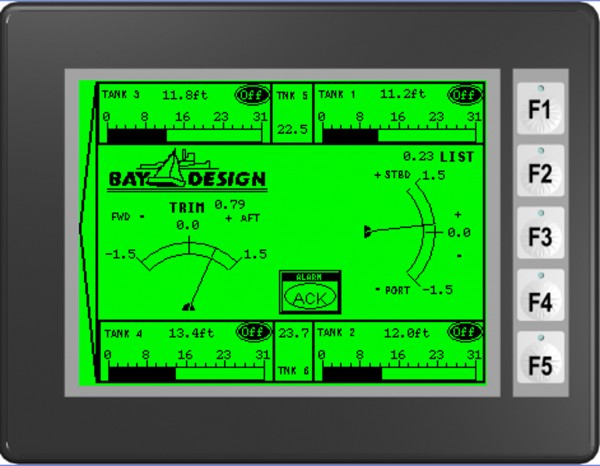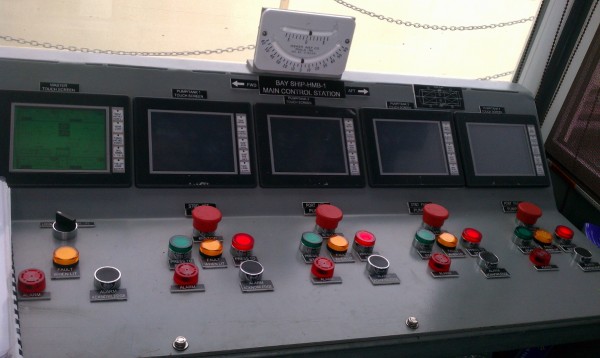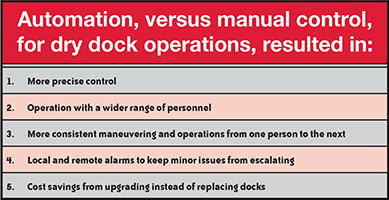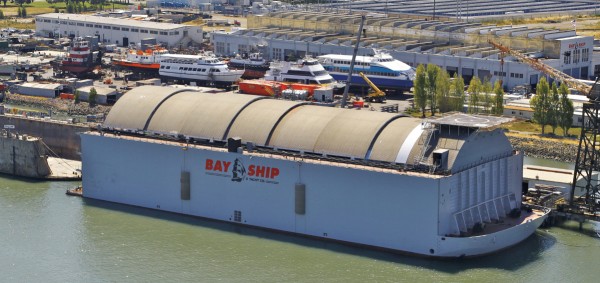A piece of Cold War history uses automation for precise control of its floating dry dock. Less expensive components and in-house engineering allowed for a more advanced system.
A covered dry dock, with a history worthy of spy novels and action movies, recently received a sophisticated automation motion control upgrade from its previous all-manual controls.
In July 2012, Bay Ship & Yacht Co. was the winning bidder at an auction held by the U.S. Navy for the Hughes Mining Barge (HMB-1) floating covered dry dock. The HMB-1 has been given new life as the West Coast’s only dry dock that is fully enclosed with a retractable roof.
 FIGURE 1: HMB-1 DRY DOCK AND SEA SHADOW SHIP
FIGURE 1: HMB-1 DRY DOCK AND SEA SHADOW SHIP
Bay Ship & Yacht was founded in 1977 by Bill Elliott to construct and repair wooden ships. The company expanded to focus on the repair, conversion, and construction of commercial vessels, military vessels, and super yachts. The HMB-1, a 6,300 long-ton submersible barge, was originally built for the CIA as part of Project Azorian, a top-secret mission to salvage the remains of the Soviet submarine K-129 from the ocean floor off the coast of Hawaii.
During the project, the 324-ft-long and 106-ft-wide barge was used in tandem with the Hughes Glomar Explorer, a deep-sea drill ship that has been referenced in novels such as The Ghost from the Grand Banks by Arthur C. Clarke and The Hunt for Red October by Tom Clancy. The Glomar Explorer maneuvered over the HMB-1, which had its retractable roof opened, to reclaim parts of the sub, without detection, via a hook device attached to the barge.
The mysterious HMB-1 was put into action again when the U.S. Navy towed it to a facility in Redwood City, Calif., to use it as a floating dry dock for the construction of the Sea Shadow, an experimental stealth ship. After the Sea Shadow project was completed, the Navy auctioned the HMB-1, along with the Sea Shadow, with the requirement that the stealth ship be scrapped (Figure 1, above).
A complete overhaul
After purchasing the HMB-1, Bay Ship & Yacht put a lot of work into revamping the barge and converting it to a 6,300 long-ton commercial floating dry dock with a 76-ft vessel beam capacity.
Originally, the barge’s floor was submerged by using a compressed air system. As part of the overhaul, the pneumatics system was replaced with one that pumps out ballast water to lower the dock. By flooding ballast tanks, operators can sink the interior floor of the dry dock beneath the level of the surrounding seawater by up to 35 feet to let vessels float in and out. During this operation, it is absolutely critical to maintain the correct trim and list of the dry dock, both going up and down, or catastrophic damage can occur to the dock, vessel, or both.
Prior to the overhaul there was no automation to control the process, so painstaking manual operation was required. To improve operation, Bay Ship & Yacht decided to fit the control system with programmable logic controllers (PLCs) and human machine interfaces (HMIs) to ensure that lowering and raising the dry dock floor was as accurate and efficient as possible, and to improve the control and monitoring of other aspects of operation.
Easier, safer automated operations
Cost-effective programmable logic controllers and human-machine interfaces were selected for the supervision and control of the dry dock’s ballast flooding and pumping. Bay Ship & Yacht designed an automation system consisting of a CLICK® PLC for each of the working ballast tanks, one for fixed ballast tanks, one master, and five C-more® Micro HMIs for display and control. Installation and programming went as planned, taking only six weeks from start to finish, due in large part to the ease-of-use of the hardware and software selected. FIGURE 2: C-MORE MICRO HMI FOR DISPLAY/CONTROL OF DRY DOCK Data from 30 discrete and 15 analog inputs are used to supervise the tank levels, the percentage open of the four flooding valves, and the two inclinometers. Analog inputs include pressure (tank level) and valve sensors in addition to the digital inclinometer that monitors the dock attitude, trim, and list. The discrete inputs include but aren’t limited to internal pump status contacts (seal fail, overheat), as well as outputs from the soft starters that communicate their status to the PLC. By using the dock attitude (positioning) and tank level data from the inclinometers, the PLC software math function performs the calculations required for the automatic control of the pumps. This ensures the tank levels and attitude are correct at all times (Figure 2).
FIGURE 2: C-MORE MICRO HMI FOR DISPLAY/CONTROL OF DRY DOCK Data from 30 discrete and 15 analog inputs are used to supervise the tank levels, the percentage open of the four flooding valves, and the two inclinometers. Analog inputs include pressure (tank level) and valve sensors in addition to the digital inclinometer that monitors the dock attitude, trim, and list. The discrete inputs include but aren’t limited to internal pump status contacts (seal fail, overheat), as well as outputs from the soft starters that communicate their status to the PLC. By using the dock attitude (positioning) and tank level data from the inclinometers, the PLC software math function performs the calculations required for the automatic control of the pumps. This ensures the tank levels and attitude are correct at all times (Figure 2).
The new automation system provides the ability to complete all operations via touch screens and console buttons. Monitoring each of the pumps, valves, and motor controllers provides precise control of the dock’s trim and attitude, which is critical when dealing with vessels that cost many millions of dollars (Figure 3).
 FIGURE 3: OPERATOR SUPERVISORY CONTROL CONSOLE
FIGURE 3: OPERATOR SUPERVISORY CONTROL CONSOLE
Since retrieval of critical information is now automated, an expanded roster of operators can use the system safely and securely, as compared to the pneumatic system, which only could be used manually by highly skilled operators.
Another important feature of the new automation system is its alarm capabilities. If preset parameters are exceeded, an alarm is triggered to notify operators of a possible problem. In addition, the system is linked to an auto dialer to notify selected personnel in case of alarms after hours.
This remote notification capability has helped correct small issues before they escalate.
Alarm, tank, and trim data are automatically logged within the PLC using the real time clock (RTC), allowing valuable trending and alarm time information to be displayed on the HMI.
Since implementing the automation system, the only issues have been minor ones that were quickly addressed and corrected.
Success for younger workers
As with many businesses, the marine industry is faced with an operator shortage as mature workers retire. Many younger workers aren’t as knowledgeable about older floating dry docks, which makes hiring and training operators time-consuming and expensive. Moreover, if there’s only one employee who can manually run the dry dock floor, operations can be severely curtailed.
Fortunately, the new automation system works so seamlessly that competent workers have been quickly trained to safely operate the floating dry dock floor under direction from the dock master. The control provided by the PLCs and displays has been so impressive that Bay Ship & Yacht is planning to install a similar system on a second older dock. This dry dock from the World War II era has little or no instrumentation, and currently only two employees can operate it.
Investment: One third the cost
When Bay Ship & Yacht started the overhaul, an automation vendor quoted $36,000 for a system that would only automate level monitoring of six tanks. That exceeded the budget, and the resulting system wouldn’t have satisfied all requirements. Bay Ship & Yacht decided to do the project, including installation and programming, in house.
Total cost for the automation system from AutomationDirect was about $12,000; $5,000 of that was allocated for the 15 analog sensors that monitor tank levels and valve positions, as well as the dock attitude, trim, and list.
Initially the plan was to use a manual stand-alone air pressure system that would provide tank data only and wouldn’t communicate with other systems. However, the money saved from purchasing less costly components and from bringing the project in house provided resources to build a more advanced automation system delivering the benefits listed in the table.
 TABLE 1: BENEFITS OF AUTOMATIONG DRY DOCK OPERATIONS
TABLE 1: BENEFITS OF AUTOMATIONG DRY DOCK OPERATIONS
Greater control offers more precise operations than ever thought possible, and the experience has facilitated replication of the project to upgrade another vessel. The purchase and automation retrofit of the HMB-1 has enabled Bay Ship & Yacht to expand capabilities to include work on wider vessels. The retractable roof also allows easier control of waste by-products, maximizes quality control for painting, and avoids loss of productivity due to bad weather (Figure 4).
 FIGURE 4: RETROFITTED HMB-1 DRY DOCK
FIGURE 4: RETROFITTED HMB-1 DRY DOCK
Bay Ship & Yacht is proud to have the opportunity to work on such a distinguished vessel as the Hughes Mining Barge, giving it a new life as a civilian floating dry dock. The project has been a success that has helped provide the best service possible for clients.
– Ben Chisolm is information technology manager, Bay Ship & Yacht; edited by Mark T. Hoske, content manager, CFE Media, Control Engineering, mhoske@cfemedia.com.
– Captain Benjamin “Ben” Chisholm joined Bay Ship & Yacht in 2009 as a naval architect and systems specialist for the marine engineering department. Chisholm, a United States Coast Guard captain, is an expert in naval architecture and maintenance. He has worked as an engineer and project manager, under sail and pier side, for numerous naval architects and yacht design companies.
By, Ben Chisolm, Christine Lesher
Originally Posted: Sept. 10, 2014


